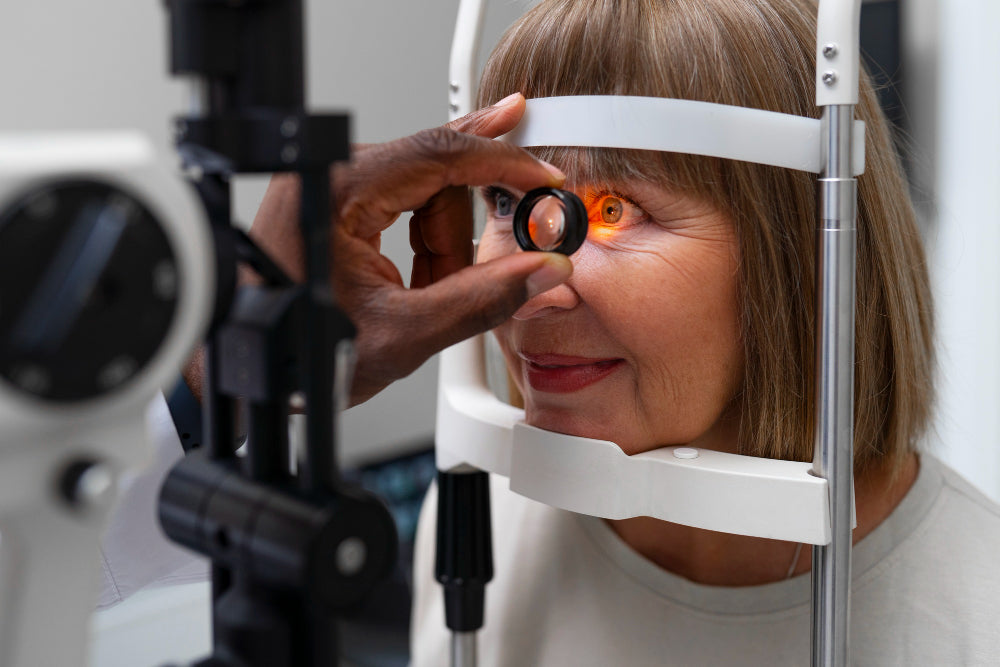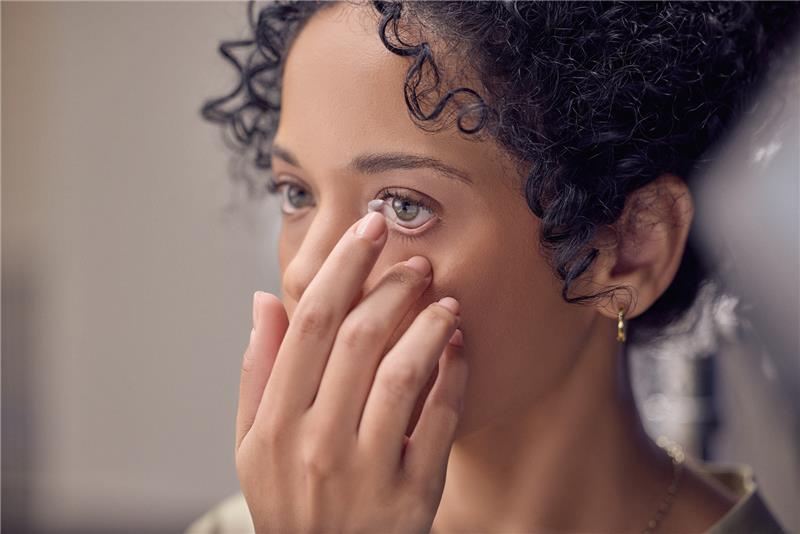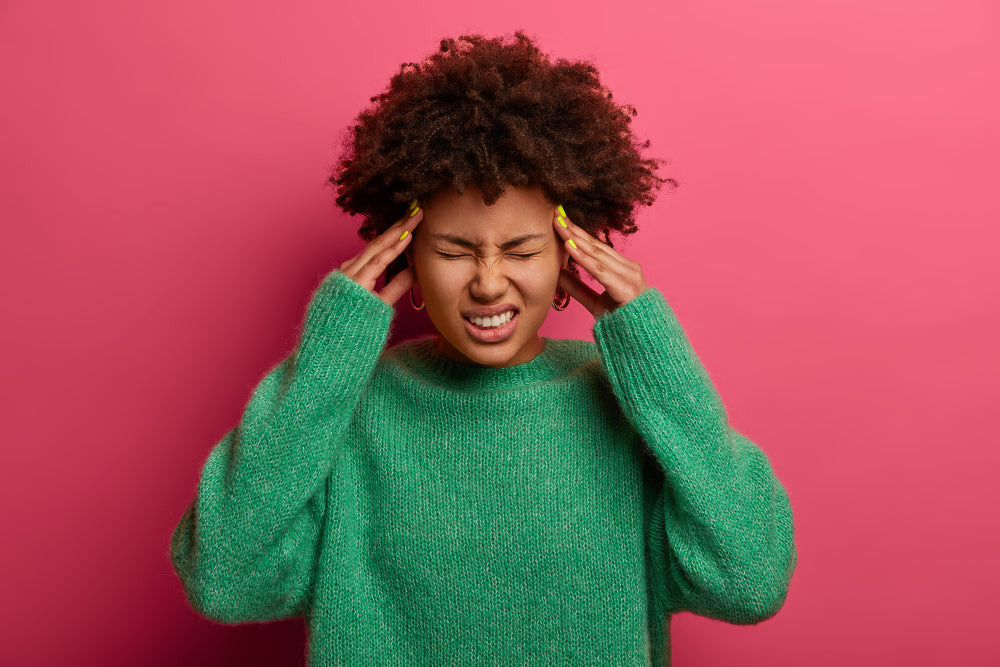Glasses barely hanging on your nose? Contact lenses might be the answer you've been searching for! But before diving headfirst into a world of freedom from frames, there's a crucial step you can't skip: the contact lens exam.
This isn't your average eye exam. It's a tailored experience designed to ensure your contact lenses fit like a dream, are healthy for YOUR eyes, and provide crystal-clear vision. Eye exams are essential for assessing the overall health of your eyes.
A comprehensive contact lens exam evaluates your eye health and checks how well your eyes adapt to contact lenses. Intrigued? Let's learn about the secrets of a contact lens exam and answer the question: what exactly happens during a contact lens consultation?
Contact Lens Exam — A Brief Overview

A contact lens exam is an upgrade that is combined with a comprehensive eye exam. In addition to determining your glasses prescription, measuring the way your eyes work together, assessing the health of the front of and the insides of your eyes, checking your eye pressure, and observing pupil function, the eye doctor (optometrist) will take additional measurements of the front of your eye called corneal topography and keratography. These additional measurements of the eye combined with patient lifestyle and expectations will guide your eye doctor in prescribing the best contact lenses for you available in today’s marketplace. At Vision Source Rio, diagnostic lenses are dispensed for evaluation by both the doctor and the patient. Specialty lenses for high prescriptions, adverse lasik outcomes and keratoconus require additional measurements and fitting and will need to be ordered. They will not be available on the day of service. If you prefer to stay in the contact lenses you are currently wearing, feel free to discuss this with the doctor as well. But be advised, they may not be the best lens for you at this moment in time.
There are several factors the eye doctor must consider before prescribing contact lenses. These include consultation, measurement, tear film analysis, eye dryness, and fitting of the lens itself.
Do note that there is a difference between an eyeglass prescription and a contact lens prescription. To start, glasses sit 12-14 mm away from the front surface of the eye vs being fit directly onto the eye. This is particularly important for patients with astigmatism and high prescriptions. And the power shift is just the beginning of the differences. With contact lenses, materials must be specified, as well as base and secondary curves, overall diameter, and wearing schedule. People often get confused and think an exam for glasses includes a contact lens prescription. It does not, due to the complexity and additional measurements and time involved with fitting contact lenses.
Due to this, you cannot determine a contact lens prescription simply from the prescription of your eyeglasses.
Questions Optometrist Ask
 Before prescribing contact lenses for you, the Optometrist will consult you. The eye doctor may ask you questions such as:
Before prescribing contact lenses for you, the Optometrist will consult you. The eye doctor may ask you questions such as:- What makes you interested in contact lenses?
- Do you plan to wear the lenses all day?
- Do you plan to wear contact lenses for particular events or a shorter period of time or do you plan to wear contact lenses full time?
- Have you worn contact lenses before?
- Do you have any allergies?
- What kind of work do you do?
- How much screen time is involved in your daily routine?
- Do you get frequent eye infections?
- Do you have issues with dry eye?
- Have you ever been diagnosed with Sjogren’s Syndrome?
Contact Lens Consultation
It's important to talk to your eye doctor prior to deciding to switch to contact lens wear. Your doctor knows what works and what doesn’t for patients just like you and can tell you exactly what to expect with contact lenses with regard to your particular vision and visual demands. Your optometrist knows more about your eyes than you do. Also, your optometrist will prescribe contact lenses for you according to your daily routine and those that fit your visual needs and lifestyle.
Many people have astigmatism, presbyopia, hyperopia, myopia, or dry eyes. For these individuals, the optometrist prescribes different types of contact lenses. The eye care professional will also ask you about your preferred wearing schedule and advise you as to exactly what types of contact lenses you would be a candidate for.
Contact Lens Eye Exam
After the exam and consultation, the next step is to try contact lenses. The contact lens exam involves several steps that guarantee the lens fits properly and delivers the necessary vision correction in a healthy manner.
Here’s an overview of the contact lens eye exam procedure:
Comprehensive Eye Exam
In this, an eye care specialist called an optometrist begins a thorough comprehensive eye exam, reviewing the patient's medical history, checking the health of the inside and outside of the eye, looking at the way the patient’s eyes work together, checking the pressure inside the eye, pupilometry, color vision testing, auto refraction and subjective refraction, starting by assessing the patient’s glasses prescription.
The eye care professional will also check for any changes in eye shape or surface that might be caused by contact lenses in previous wearers. The comprehensive test helps identify the underlying eye issues.
Eye Surface Measurements
Contact lens fitting is a critical part of the contact lens exam, ensuring that your lenses fit properly. The optometrist will measure your eyes using a keratometer to assess the corneal curvature and a corneal topographer to gauge the cornea's size and shape.
These measurements help determine the right size and shape for your contact lenses. Accurate sizing is important for comfort and clear vision. Additionally, pupil size is measured to ensure proper vision through multifocal and cosmetic lenses.
Tear Film Evaluation
If you have dry eyes, contact lenses may be uncomfortable and could make the dryness worse.
The eye doctor will check how moist your eyes are by assessing the health of the tear film. Other methods include using ophthalmic dyes or incorporating additional measurements. Depending on the results, the optometrist may give you a lens that provides additional moisture.
Contact Lens Fitting
The final step is lens fitting. You'll start out using a diagnostic lens to assess its movement and alignment on your eye. After a few days of wearing these lenses, you may be asked to return to your eye care professional to discuss your experience and any issues. If you are an experienced contact lens wearer a phone call to the contact lens technician may suffice.
The lenses should fit comfortably and feel almost invisible. The eye care professional will use a slit lamp biomicroscope to check lens movement and eye health and will test your visual acuity and refraction over the contact lenses to ensure proper lens performance and optimal visual correction.
Key Takeaways

A contact lens exam is an enhanced version of a comprehensive eye exam. It assesses the health of your current lenses and helps prescribe new ones. The cost begins around $60 for a person staying in the same type of lens with no prescription change. However costs can vary widely depending on the complexity of the contact lens fit and patient expectations with regard to lens performance.
Beyond lens evaluation, this exam can uncover issues like corneal ulcers, corneal scars, corneal shape changes, dry eyes, and allergic reactions to lens solutions. The exam quality depends on the optometrist's knowledge and expertise, so choosing a skilled professional is crucial.
Vision Source Rio offers top-notch care from a team of dedicated experienced optometrists. Schedule your appointment today to ensure your vision is in the best hands!
Explore Further:





